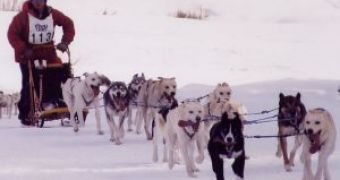We are more used to see beasts like horse, donkey, mule, cattle, buffalo, camels, llama, yak, or elephant being used as working animals. At least in the documentaries. But in the 19th century Europe, dog traction was a popular mini-version of horse traction. Usually, dogs were harnessed to a two wheel (rarely four wheel) cart, rarer in groups of two or four animals, being the "horse of the poor people", like small trade-producers (bakers, milkmen, greengrocers). The preferred breeds were the Great Dane, Saint-Bernard and German Shepherd, but other breeds were used too.
But dog traction is an ancient tradition (in northern polar zones) and it is still practiced (both in Arctic and in Antarctica). Dog sleds are used in the tundra areas for over a millenium, mainly for transporting goods. The first written account came from Arab literature. Chukchi people from northeastern Siberia could have been the first human population employing sled dogs.
The sleds are "Eskimo type" (with its variants in Alaska, Canada and Greenland) and "Asian type" (Siberia). The employed harness varies also with each area. The "individual" equipage (employed by Eskimos and Ostyak people in Western Siberia) is made of animals bound directly to the sledge. This equipage type presents variants of "frontline fan", "elongated fan" or "extremely elongated fan". In the collective equipage, there is a main belt to which the dogs' individual harnesses are bound. The animals are placed alternatively, by each side, with one dog in front, or in pairs with one or two dogs in front.
In an equipage, the dogs form a homogenous group, inside of which one dog comes off as the undisputed chief and it is not the one in front of the equipage. The front animal is usually a rapid and intelligent bitch. The front dog can be 15-20 m (50-66 ft) away from the human driver. On darkness or low visibility conditions (like snow storms) it can be completely out of the driver's visual range. That's why the front dog has to sniff the path and choose the least dangerous pathway, independently from the human master. A good front dog can allow the driver to take a nap during the long races, if the pathway is right.
The "authoritative" chief is obeyed, feared and followed by the other dogs and he must lead his group in all the situations: the most difficult paths, the chase of a polar bear, fight with another equipage. The training is simple and severe: at the right age, the puppy is harnessed near its mother and it involuntarily learns the commands, its place on the harness and its social hierarchy in the equipage.
During the polar summer, dogs are released in Greenland and Canada in order to eat by themselves. At the sledge, the driver herds the dogs using his voice and a long whip. In Alaska, "gee" is "right", "haw" "left", and "whoa" "stop". Generally, "march" has been replaced by "hike" or "let's go". An impressive snow hook is used like an anchor to impede anxious dogs from disobeying their owner.
The performances of the dog equipages can be amazing. In Greenland, 8-10 dogs carry 250-300 kg for 50-60 km daily. In Canada, 12-15 dogs can carry 600-1,000 kg, 12-15 hours daily. Canadian Indians using sledges with 4-10 crossbred dogs (inferior to the Eskimo dogs) carry 200-400 kg of cargo for 14-16 hours daily, on rough terrain.
A good dog crew makes about 19 km (12 mi) per hour, on short periods even 30 km (19 mi) per hour. Usually, during long races (of more than 10 days) they make 160 km (100 mi) per day, with an average speed of 7 km (4 mi) per hour. Still, the dog must not move a weight larger than its body. In the case of a crew made of 15 dogs, each dog must not carry over 15 kg (33 pounds), while a sled dog has an average weight of 25 kg (56 pounds). An average race sled weighs 140-230 kg (311-511 pounds).
Unlike the reindeer, the sledge dogs present the disadvantage of requiring high amounts of food, mostly dry fish. Sometimes, the driver runs in the back of the sled, pushing and helping the dog crew climb a hill or cross a rough terrain. But the presence of the reindeer is connected to that of the tundra likens, the only fodder in the tundra.
The rush for gold in Alaska would not have been possible without these dogs. Many polar explorers relied on them, the dogs being even eaten in some circumstances. Sled dogs are generally called Husky. The most renowned sled dog breeds are Samoyed (western Siberia), Alaskan Malamute, Siberian Husky, Alaskan Husky, Indian Dog, Canadian Eskimo Dog and Greenland Dog. The Alaskan Malamute was first discovered by Russian explorers at an Inuit (Eskimo) tribe at Kotzebue Sound (called Mahlemut or Malemiut). It is big and powerful and proved fit for carrying large weighs during the gold rush. Its slowness is compensated by extraordinary power and stamina.
The Siberian husky is blue-ice eyed, small, rapid, and intelligent. It is a distinctive breed, unlike the Alaskan husky, with few distinctive traits. It is a crossbreed and its name has the same root as "Eskimo": "raw-meat eater." Indeed, in the past, the drivers fed them with dry fish. The Indian Dog is a selected breed from the rural areas of Alaska. It can make one kilometer (0.6 mi) in 2 minutes and can make 30 km (19 mi) with a top speed of 27 km (17 mi) per hour, being still able to tract next day. The most famous sled dog race is the Alaskan Iditarod Trail, 1,800 km (1,120 mi) long, starting from Anchorage to the final point Nome, on northwestern Alaska. It began with the gold rush in Alaska in early 20th century.

 14 DAY TRIAL //
14 DAY TRIAL //